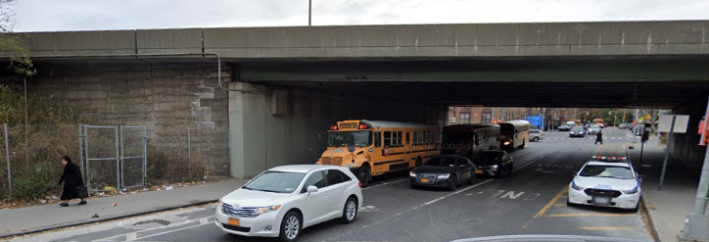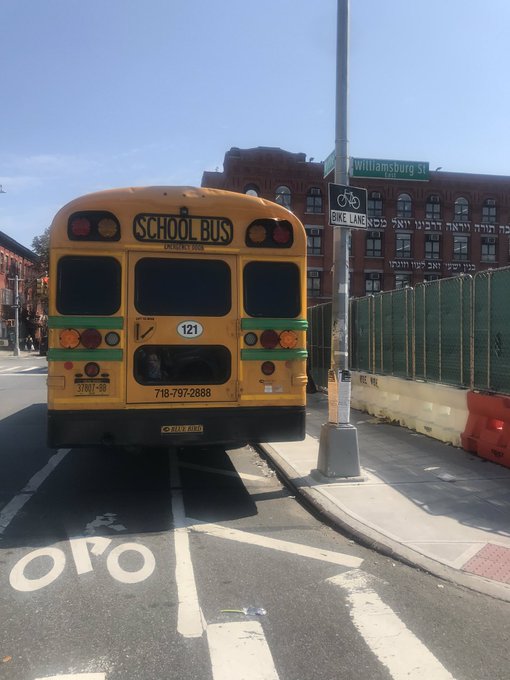A top Brooklyn police commander said that a notoriously dangerous intersection where a 35-year-old cyclist was killed in September should be redesigned so that cyclists and pedestrians are physically separated from reckless drivers because nothing else will work — though activists still blamed police for not doing enough now.
Meanwhile, the Department of Transportation claimed it can't make any changes, yet, but the reason was, for lack of a better term, bureaucratic.
Captain Mark Vazquez, the commanding officer of the 90th Precinct, which includes the intersection of Wythe Avenue and Williamsburg Street East, where a private charter bus driver killed Brooklyn prosecutor Sarah Pitts on Sept. 7, said that he and his rank-and-file cops could stand at that location every day, handing out hundreds of tickets to drivers, but it would not make anyone safer until the city actually redesigns the deadly corner.
"That intersection needs certain engineering fixes to make it safe,” Vazquez said during Community Board 1’s virtual Transportation Committee meeting on Tuesday night. “I could write 3,000 summonses there, it’s not going to make it safe, because we can't be there 24/7 writing summonses. There has to be something engineering-wise that could prevent a car or bike entering that intersection at the same time when they're not gonna be aware of each other.”
Currently, the Wythe Avenue bike lane remains unprotected as it cuts under the overpass of the Brooklyn-Queens Expressway — and the on-ramps to that highway flank Wythe on either side, where drivers often speed and blow past the red light. And what makes the dangerous stretch even more treacherous are the private Yeshiva school buses and private tour buses that regularly, and illegally, park in the bike lane.

Vazquez claimed that, as is usual after a fatal crash, cops from the local precinct stationed themselves near the intersection for 28 days to hand out summonses, and survey the dangers of the street.
But there’s no evidence that cops actually ticketed any of the private buses parked in the bike lane after Pitts’s death — when Streetsblog visited the scene just one day after Pitts was killed, cops sat idling in their squad car as motorists parked in the bike lane, and sped up to make the light through the same intersection, enraging friends of the victim who were across the street lighting candles and hanging flowers at a makeshift memorial.
I am at the corner of Wythe and Williamsburg Street East, where 35-year-old Sarah Pitts was killed by the driver of a charter bus yesterday pic.twitter.com/f5kIyJ4x9O
— Julianne Cuba (@Julcuba) September 8, 2020
Board members and cycling advocates again blasted the NYPD for not doing enough to stop the cars and private buses from illegally parking in the bike lane, putting cyclists in danger when they're forced to swerve out of their way into the lane of moving traffic.
"Why is a bus stop being allowed to happen all day long, all night long in a bike lane?" said committee member Ryan Kuonen during the meeting. "They're regularly parked there for massive amounts of time, private Yeshiva buses. Is there ever going to be enforcement of the thing that puts all of us that cycle there in danger every single time?"
The NYPD declined to provide the number of tickets issued to both motorists and cyclists in the month following the crash, but Vazquez said that generally, summonses “were way down from last year” because of the COVID-19 crisis.
But Vazquez said the NYPD did ask the DOT to install a signal for cyclists that’s more visible from the bike lane — a rare flip of the traditional relationship of the NYPD and the DOT.
“The tunnel is obviously dark, it’s hard to see when you’re approaching that intersection, especially if you’re a bicyclist in that bike lane, you’re not really gonna see the cars coming," said Vazquez. "It’s obviously a visibility issue, which is why we requested to get a bike light there."
But the issue is not just poor visibility, but a lack of physical protection, too, according to civic members.
“Why can’t we put jersey barriers or something to protect the bike lane to stop buses from using it as a parking lot?” said Karen Nieves, a member of the committee.
A staffer for DOT claimed that’s not possible unless someone, or some organization, volunteers to clean the bike lane themselves since the agency doesn’t have the proper equipment to do so — an ongoing issue the city has failed to solve, which has made other bike lanes unsafe, including on Grand Street.
“That’s not something we could do with the design as it is without a partner who would be able to to clean the bike lane," said Ronda Messer, who works in DOT's Brooklyn office. "There’s not enough room to get a broom or a plow there, but this came up more than once and without a partner that's able to consistently remove debris and snow, it's not an option. We can't put a barrier the way the design is now."
Messer added that DOT is, however, "looking to do a redesign."
A spokesperson for DOT said the agency is "aware of the concerns" and is working with the "community to find feasible, safe solutions," but did not immediately respond to follow-up requests for comment about the need for a so-called community partner to help clean the bike lane.
So why the hold-up?
The conversation about fixing such a dangerous intersection that has long been a plague in the community was derailed when a longtime anti-bike lane crusader questioned the captain on the exact details of the crash again, asking why the NYPD would make recommendations based on this one “accident,” when Pitts was the one who went through the red light.
"We made recommendations based on this accident, but what exactly happened?" said Simon Weiser, who co-chairs the transportation committee. "Let's get the facts."
Vazquez reiterated that the details of this particular crash are irrelevant to the need for a redesign.
“There’s no disputing what happened. I don’t want to blame anyone, we shouldn't blame the biker or driver, but that intersection needs certain engineering fixes to make it safe,” he said.
And the co-chairman of the committee said nothing will ever get fixed if the focus is on what any particular cyclist did or didn't do, not what can be done to finally make the intersection safer.
"The recommendation is in response to this accident, but it's a problem that's existed for a long time," said Eric Bruzaitis. "We keep getting bogged down in the details, but it happened because of problems that exist at this intersection, not because the cyclist ran a red light."






